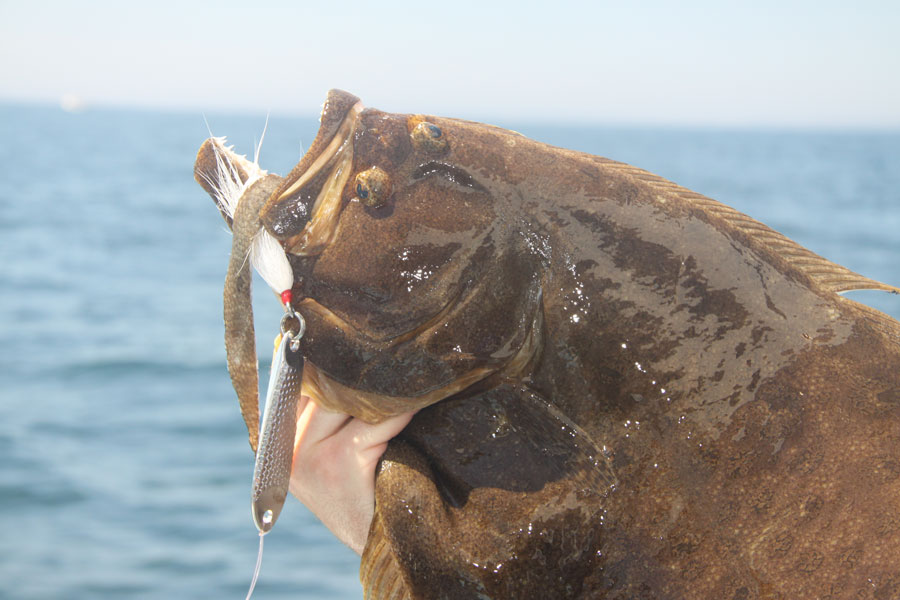By Tom Schlichter

Hard to imagine, but Long Island’s short fluke season isn’t far from its end. While in decades past anglers could target the tasty and feisty summer flatfish, current regulations draw the fun to a close on September 17. Fortunately, late July and August produce some of the year’s biggest flatties so if you want to make a stand, you are in prime time. Double-digit fluke this month and into to September are a real possibility in Long Island Sound, along Long Island’s South Shore and, especially, in the waters off Montauk and Block Island.
One key to hooking-up with keeper fluke that fall in the “no doubt” class is to concentrate your efforts in deep water. You’ll find them in well-defined channels leading toward inlets and harbor mouths and in the open ocean from half a mile to three miles off the beach. On Long Island Sound, look for action with big fish along ledges and submerged boulder fields in 50- to 80-foot depths.
This deep water action with summer flatties isn’t a light tackle affair. In fact, it’s quite the opposite. Bring along a light ocean bluefish setup, your favorite conventional setup for pulling porgies and sea bass off ocean wrecks, or that same rod and reel you like to use when clam-chumming in strong currents under channel bridges. Leave your ten- to 14-pound test spinning gear in the rod rack because it’s not sturdy enough to handle the weights and big baits you should be using to target these brutes. I like to use a 20-pound class outfit but many anglers bump it up another notch to 30-pound test. If fishing with braid, 50- to 60-pound test with a long, 30-pound test mono or fluorocarbon leader is about right.
Typically, rigging for this action consists of a standard bottom rig featuring a #3/0 to 4/0 wide gap or Sproat style hook. The hook should be tied in to the main line via a dropper loop or three-way swivel positioned two to six inches above the sinker. A three-foot leader of 30 to 40-pound test mono connects the hook to the main line. This is nothing more than the standard bay rig for fluke, except that the hook size is larger and your sinker will run heavier. Expect to need 4 to 8 ounces of lead to hold bottom in most areas.
While gear this heavy may seem like overkill for fluking, keep in mind that you’ll be using big baits, heavy sinkers and dealing with fish that may reach doormat proportions. Fluke of six to eight pounds are always a possibility when you fish big baits in deep water at this time of the year, and three to four-pounders are relatively common. Summer flatties this size can put up a commendable tussle even when tugging against such heavy sticks.

For early- and mid-summer fluking inside the bays, sand eels, spearing and live killies make excellent baits. But for late summer doormats you’ll need to switch to something bigger. Trade in those tiny baits for large smelt, 6- to 8-inch fish or squid strips, a live 6-inch snapper blue or a fresh-dead peanut bunker. These big baits present a more wholesome looking meal than does a small killie or shiner. They offer a doormat something to get excited about, a meal worth chasing. Better still, they discourage smaller fish from biting which gives the big boys a better chance at getting to your bait.
If you choose to go the live bait route, you’ll find a slip-sinker rig works well. Hook the live bait through the nostrils or through the lips. A twenty to forty-foot drop-back when a hit is felt should allow the predator to ingest your offering deep enough to ensure a solid hook-up.
There are several big fish hotspots that are worth the ride if big, late-summer fluke are on your hit list: Ambrose Channel right out in front of New York City is one. This run gets started in mid-to late August and runs right through the end of the season. Catches are best here along the channel edges, as you might expect. The other spot you don’t want to miss out on is Montauk. Here the action centers on the south side between Montauk Village and the Castle area east of Shinnecock Inlet. Another spot of note is the extreme western end of Long Island Sound. Some very large fluke are culled from the waters around the Throgs Neck and Whitestone Bridges most years. As at Ambrose, the Sound fish have come mostly from ledges and channel edges. Block Island is yet another spot worth the ride, especially in mid-August as the fish there seem to bunch up a bit as the first hints of kinks in summer’s armor make themselves known in the form of refreshingly cool evening temperatures.
Of course, these are not the only hotspots. Virtually any near shore ocean or Long Island Sound wreck, artificial reef, inlet mouth or major, near-shore channel can sport double-digit doormats s the summer winds down. If you can’t get to Ambrose, Montauk or Block Island, simply work your favorite deep-water blackfish, sea bass or porgy wreck, the edge of a mussel bed, or ocean hump. Choose big baits that sea bass and scup will ignore, and drift along the edge of structure.
Pick your days carefully when planning an ocean fluke trip. You’ll want to head out when conditions are conducive to good drifting. Avoid new and full moon tides as they result in too much current, and hope for wind speeds of less than 15 knots. The combination of strong winds and moon tides can make for tough fishing so keep an ear to the weather report and plan accordingly.
By Tom Schlichter









